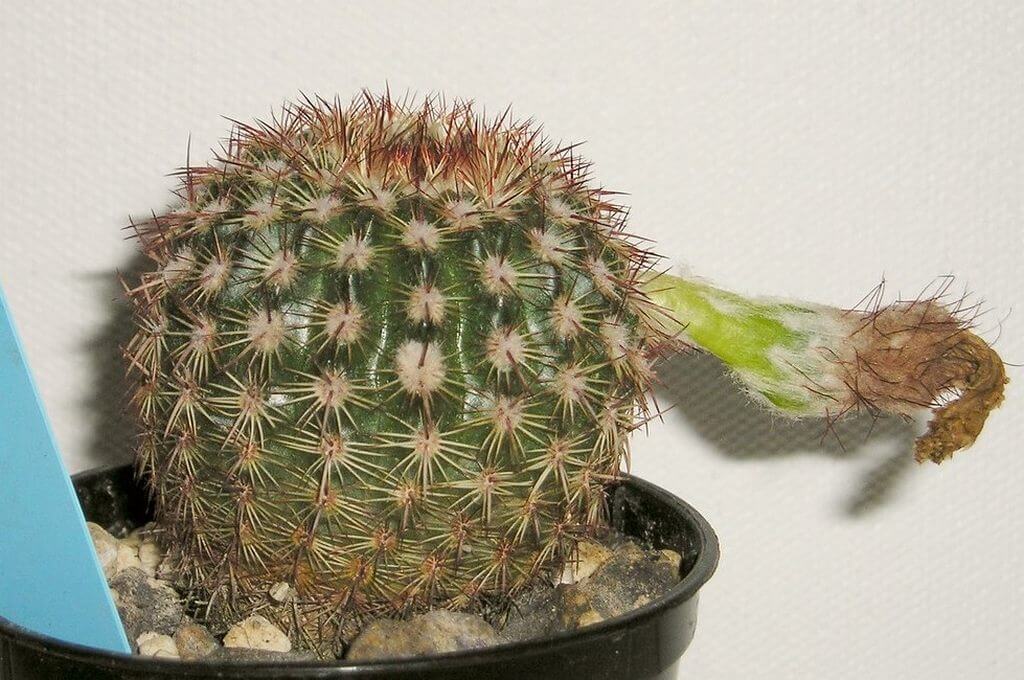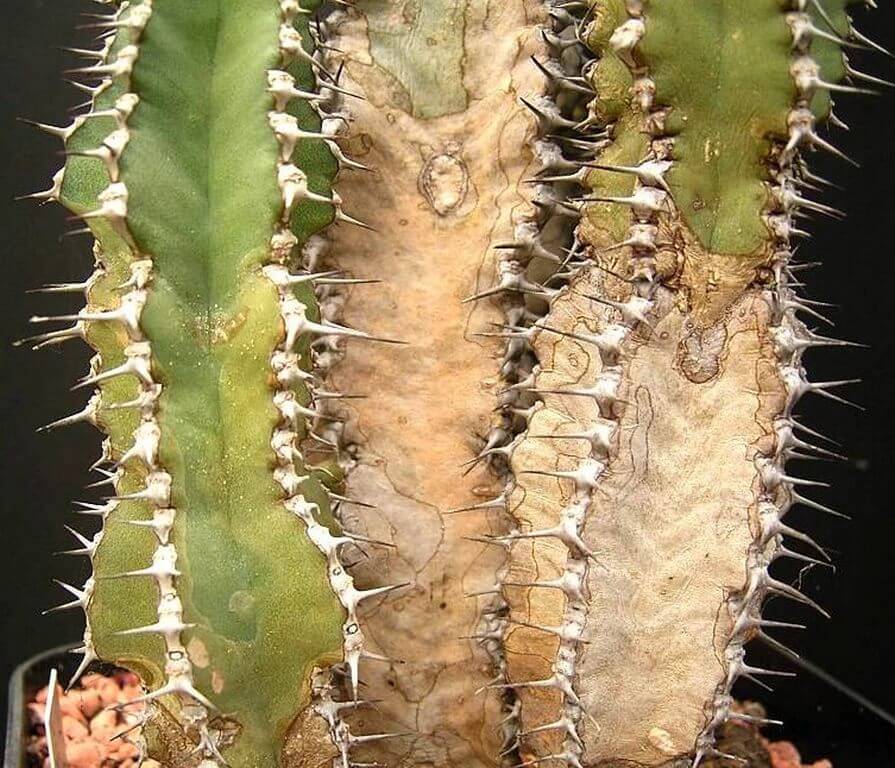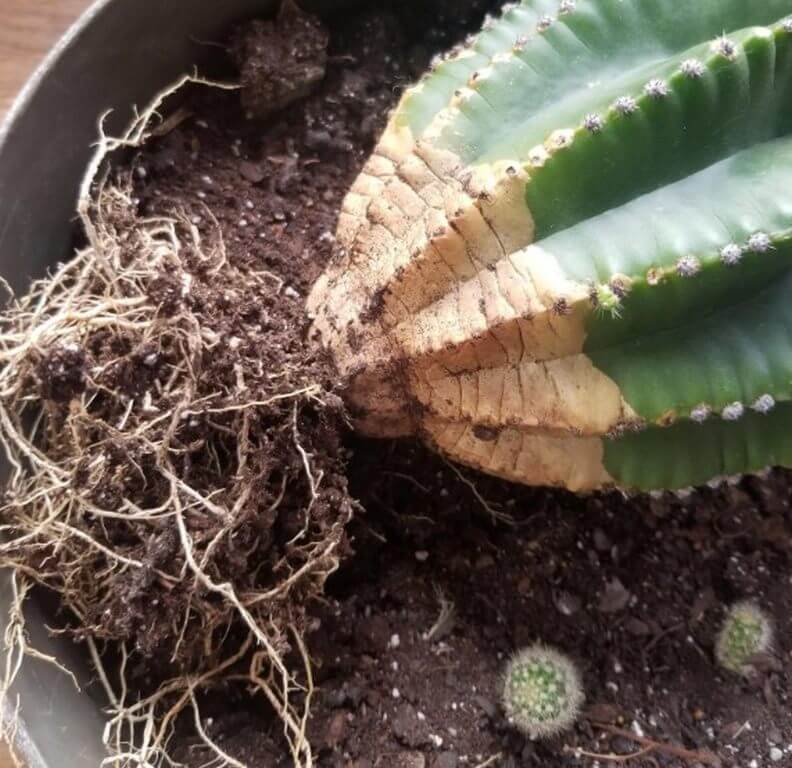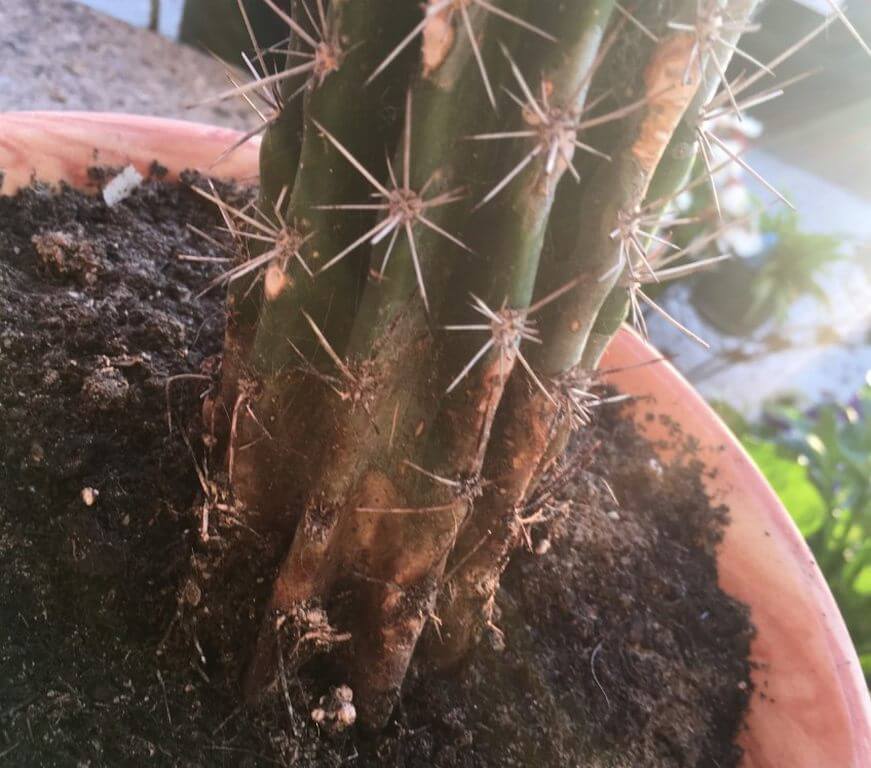We who care for these hardy yet delicate cactus varieties often come across the puzzling thing called cactus corking. It means the plant grows a cork-like material at the bottom or on the stem.
This can confuse those who like cactus plants. It is important to notice when the corking starts. This can tell us how healthy the plant is and what we must do from then on. We aim to lessen what stresses the plant so it does not get this and stays lively and strong.
In this guide, we will look closer at what cactus corking is about. We will stress how important recognizing it early is. We will then say what steps to take after on the plant part with cork.
To give the best care plan, we will go into detail on the different ways to treat that help the plant fix itself and do well again. Follow along as we uncover how to bring back the splendor and toughness of these desert jewels.
Key Takeaways
- It is important that we learn all about cactus corking to keep our cactus plants sturdy.
- Seeing corked parts soon means we must make smart choices on treatment.
- Giving the correct care is essential to fight signs the plant is stressed.
- Treating the plant means more than just making it better, it helps it long term too and stops it happening again.
With help from those experienced, we can be sure our care of succulents feeds and helps them.

Understanding Cactus Corking
- Development of woody, brown patches on the stem
- Area of corking feels firmer compared to the rest of the plant
- The corking starts from the base and may ascend
- Distinct boundary between healthy tissue and corked tissue
Understanding these signs and symptoms is key to providing prompt and effective care for our cacti, ensuring that they remain vibrant and robust despite the challenges posed by this condition.
Remember, timely intervention can make a significant difference in the health of your cactus.
| Aspect | Natural Aging | Corking |
|---|---|---|
| Texture | Woody tissue develops slowly | Quick formation of hard areas |
| Color | Consistent with the rest of the plant’s color palette | Noticeably brown compared to the vibrant green of new growth |
| Location | Typically starts at the base and is even | Can appear anywhere, often uneven |
| Stress Factor | None – purely age-related | Often indicates environmental stress or damage |
Common Causes of Cactus Corking
Another source of concern is physical damage caused by handling, accidental bumping, or other mechanical injuries.
Cacti may respond to these traumas by developing a corky layer as a defensive mechanism. Furthermore, infections, including those caused by bacterial or fungal agents, can prompt a similar protective response.
This is why it’s imperative to keep a close eye on any cuts, bruises, or discolorations that could indicate an underlying infection, potentially leading to corking.
The other problem from changing color is Cactus Turning White, this problem can lead to the death of the cactus.

Watering Issues: Overwatering and Underwatering
Last but not least, improper watering, encompassing both overwatering and underwatering, can contribute significantly to corking.
Excess water can lead to a spongy base and eventual corking, while a lack of moisture can cause the cactus to dry out and become corky in a desperate attempt to conserve water.
Establishing a balanced watering regimen that suits your cactus’s needs is essential for its longevity and the prevention of corking. A good rule of thumb is to allow the soil to dry out completely between waterings, but also to ensure that the plant receives a deep soak whenever irrigation is provided.
| Stress Factor | Description | Impact on Cacti | Preventative Measures |
|---|---|---|---|
| Environmental Stress | Extreme temperatures, sudden climate changes | May trigger corking as a stress response | Maintain stable temperatures, gradual acclimation to changes |
| Physical Damage | Cuts, bruises, mechanical injuries | Corking as a defense mechanism to protect wounded areas | Handle with care, protect from potential harm |
| Infections | Bacterial or fungal invasions | Can lead to the development of corked areas | Keep an eye on cuts, ensure sanitary conditions |
| Improper Watering | Too much or too little water | Overwatering leads to sogginess and rot; underwatering causes drying and corking | Moderate watering, allow soil to dry between sessions |
How Corking Affects Cactus Health
As enthusiasts devoted to cactus care, we understand that cactus health is paramount. Corking, though a natural part of some cactus species’ maturation, can have profound effects on corking.
Let’s explore these implications to offer insight into this condition’s impact on plant growth, disease susceptibility, stem strength, and overall plant vitality.
Some may perceive the hard, woody texture that characterizes corking as merely an aesthetic change; however, it’s essential to recognize that this can be indicative of more serious health concerns. Below we outline how corking can signal a compromise in various aspects of a cactus’s well-being.
- Plant Growth: Corking may slow down or completely halt the vertical or lateral growth of the cactus, leading to a stunted appearance.
- Disease Susceptibility: As the cactus’s natural defense is compromised, there’s an increased risk of bacterial and fungal infections taking hold.
- Stem Strength: Over time, corking can weaken the stem’s integrity, potentially leading to structural issues, especially in larger cacti.
- Overall Vitality: A cactus battling excessive corking may exhibit a general lack of vigor, seen in fewer blooms or the dulling of vibrant colors.
To provide a clear view of the potential effects of corking on cacti, we’ve compiled a table to contrast the health status of a well-maintained cactus against one experiencing significant corking issues.
| Health Factor | Healthy Cactus | Cactus with Corking |
|---|---|---|
| Growth Rate | Consistent Growth | Potentially Stunted |
| Disease Resistance | Highly Resistant | Increased Susceptibility |
| Stem Robustness | Strong and Upright | Weakened Structure |
| Vitality Indicators | Lush and Vibrant | Diminished Vitality |
Our guided approach to cactus care should aim to minimize these adverse effects by offering a nurturing environment for our cacti. Judicious monitoring and responsive care are crucial in preventing and mitigating the effects of corking, preserving plant growth and overall plant vitality.
We advocate for the well-being of all cactus varieties, ensuring their long-term health and beauty through informed and dedicated care.
Preventative Measures for Cactus Corking
In our efforts to safeguard the health of our cherished cacti, we recognize that the best defense against corking is a proactive approach encompassing several key aspects, notably preventative care.
By establishing the correct environment and regimen for your cacti, you are laying the groundwork for their long-term vitality and resilience to stress-related conditions like corking.
Proper Soil and Watering Techniques
One fundamental aspect of preventive care for cacti is the utilization of proper soil that facilitates adequate drainage. A well-draining soil mix minimizes the risk of waterlogging, a condition that’s detrimental to cactus health. Coupled with this is the implementation of precise watering techniques.
Overwatering can lead to root rot and stress-induced corking, while underwatering can also trigger stress. Here’s how to water your cactus the right way:
- Water thoroughly, allowing the water to drain out of the pot’s bottom.
- Wait until the soil is dry before the next watering session.
- Adjust the frequency of watering based on the season: reduce in winter and increase in summer.
Choosing the Ideal Location for Your Cactus
Another vital element of preventative care is choosing the ideal location for your cactus. This involves assessing levels of direct sunlight and ensuring ample airflow. While cacti thrive with plenty of light, too much direct sun can cause sudden temperature spikes leading to stress.
The ideal location marries bright, indirect sunlight with protection during the hottest parts of the day. Here are pointers to find the perfect spot:
- East or south-facing windowsills are often suitable for ensuring cacti receive ample morning light.
- Avoid placing your cactus in areas susceptible to drafts or rapid temperature fluctuations.
- Rotate your cactus periodically to ensure even light exposure and prevent leaning towards the light source.
Minimizing Stress Factors: Heat and Cold Insulation
Lastly, to preempt corking, it’s critical to minimize stress factors by providing both heat insulation and cold protection.
Insulating your cactus from temperature extremes will stabilize its environment, and encourage healthy growth. Here are tips to protect your cacti against the elements:
- In hot climates, utilize shade cloths to diffuse intense sunlight and reduce heat.
- During winter, move your cacti indoors if they’re not cold-hardy, or provide a frost cloth as a protective measure against freezing temperatures.
- Consider using insulation materials like pumice or straw around outdoor cacti to maintain a consistent root temperature.
By attending promptly to these aspects of care, you not only bolster your cacti’s defenses against corking but also improve their overall well-being.
And always remember: If you acquire a new plant, plant right away into appropriate soil and conditions to avoid unnecessary stress that could lead to corking.
Steps to Treat Existing Corking in Cacti
When faced with the challenge of corking in cacti, the path to revival begins with strategic treatment steps.
Our expert guidance will assist in restoring your cactus’s vitality, emphasizing the importance of assessing corking severity, executing pruning with proper techniques, and nurturing through the recovery process towards healthy regrowth.
Assessing the Severity: When to Take Action
The initial and most crucial step involves carefully examining the extent of the corking. Not all corked tissue signifies an immediate problem, and sometimes the best action is inaction.
However, should the affected tissue impede growth or compromise the structural integrity of the cactus, it becomes imperative to intervene. Our approach aligns with the plant’s natural healing abilities, ensuring judicious decision-making that prioritizes the plant’s health.
Careful Pruning: Tools and Techniques
In instances where pruning cacti is deemed necessary, selecting the appropriate pruning tools is essential. We opt for sterilized, sharp instruments designed for succulents to minimize trauma.
Our pruning methodology is meticulous, focusing on removing only the necessary affected tissue with precision to prevent undue stress to the plant. This promotes a swift healing response, setting the stage for robust regrowth.
Aftercare: Ensuring Recovery and Regrowth
Post-pruning rehabilitation is crucial for fostering a conducive environment that aids in the cactus’s recovery. We stress the importance of presenting a stable environment and endorse a strategic monitoring schedule to oversee the regrowth phase.
By adopting these conscientious aftercare practices, the cactus is duly supported on its journey back to health, with the ultimate aim of flourishing unaffected by its past afflictions.
The Path to Recovery: Helping Your Cactus Heal
In the journey to restoring health in a corked cactus, creating a nurturing healing environment is critical. As we wrap up our comprehensive guide, we reaffirm that although the healing process may require time and attentiveness, the recovery path is well carved out through consistent care.
The resilience of cacti allows even a damaged cactus to recover, rebounding to its former glory with the correct measures. Understanding the caveats of untreated corking is instrumental in ensuring that we do not overlook the preliminary signs that demand our attention.
Effective damaged cactus care is all about patience, as these plants heal on nature’s clock. By adhering to the guidelines we’ve shared, from selecting the ideal soil and maintaining optimal watering habits to strategic pruning and protection from environmental stressors, the prospects for revival are promising.
Akin to nursing a wound, it’s essential to provide your cactus with a stable environment, free from the factors that could exacerbate the corking condition.
In our mission to assist you and your green companions, we encourage a proactive stance on prevention. By cultivating a bond with your cacti, learning to interpret their needs and respond accordingly, achieving cactus recovery becomes a fulfilling part of the care routine.
As dedicated custodians of these hardy yet sensitive plants, our reward is witnessing their steadfast return to vigour, ensuring that our spiky friends continue to enhance our space with their unique beauty and resilience.
FAQ
What exactly is cactus corking?
Cactus corking is a condition where a cactus develops areas of hard, woody tissue, typically at the base or along the stem. It can be a natural part of the aging process or a response to stress factors, and it’s identified by the appearance of brown, cork-like areas on the plant.
How can I tell if my cactus is corking?
Signs of corking in cacti include developing tough, brown, woody areas on the stem or at the base of the plant. It might initially appear as small bumps and, over time, develop into larger patches of corked tissue.
What causes cactus corking?
Common causes of corking include environmental stress like extreme temperature changes, physical damage or infections, and improper watering practices, whether it’s too much or too little water.
How does corking affect a cactus’s health?
While corking can be a normal aging effect, excessive or premature corking can lead to stunted growth, increased susceptibility to diseases, and weakened stem strength, affecting the cactus’s overall vitality.
What are some preventative measures to avoid cactus corking?
Preventative measures include using well-draining soil, providing proper watering, placing your cactus in an ideal location with appropriate sunlight and air circulation, and protecting your plant from extreme heat and cold.
What steps should I take to treat a cactus that’s already corking?
Treatment involves assessing the severity of corking to decide whether to take action, carefully pruning affected areas with the right tools and techniques if necessary, and providing aftercare to promote recovery and regrowth.
Can a cactus recover from corking, and how can I help it heal?
Yes, a cactus can recover from corking with proper care. Post-treatment, the focus should be on creating a stable and supportive environment to encourage healing, which involves proper sunlight, watering, and protection from environmental stress.



